|
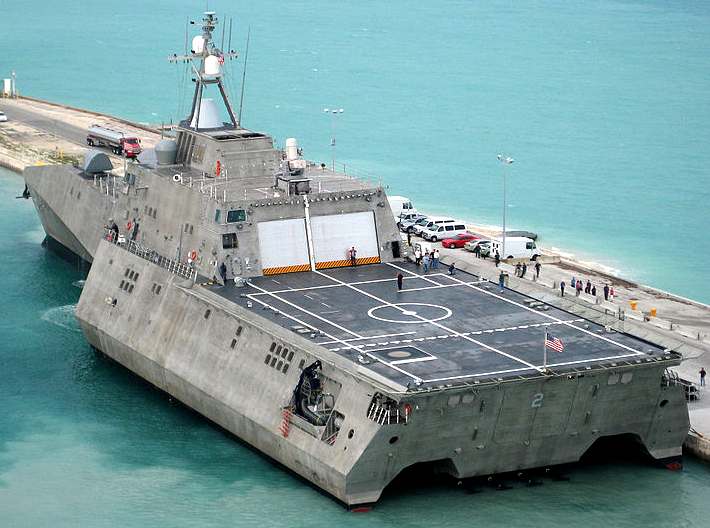
The
USS Independence. Both
US Navy littoral combat designs look more like stealth helicopter pads. Not a
missile in sight. There is though one small deck gun and the gray color at least
makes her look like a naval vessel. There are though, fears about using this
ship in oceans that are potentially littered with sea
mines.
A littoral combat ship (LCS) is a class of relatively small surface vessels intended for operations in the littoral zone (close to shore),
first coined by the United States
Navy.
The concept behind the littoral combat
ship (Ref: former Secretary of the Navy Gordon R. England) is to "create a small, fast, maneuverable and relatively inexpensive member of the DD(X) family of ships."
A
littoral ship is easy to reconfigure for different roles, including:
1.
anti-submarine warfare,
2.
mine countermeasures,
3.
anti-surface warfare,
4.
intelligence, surveillance and reconnaissance,
5.
homeland defense,
6.
maritime intercept, special operations, and logistics.
Due to its modular design, the LCS
is able to replace slower, more specialized ships such as minesweepers and larger assault ships.
It was "envisioned to be a networked, agile, stealthy surface combatant capable of defeating anti-access and asymmetric threats in the littorals."
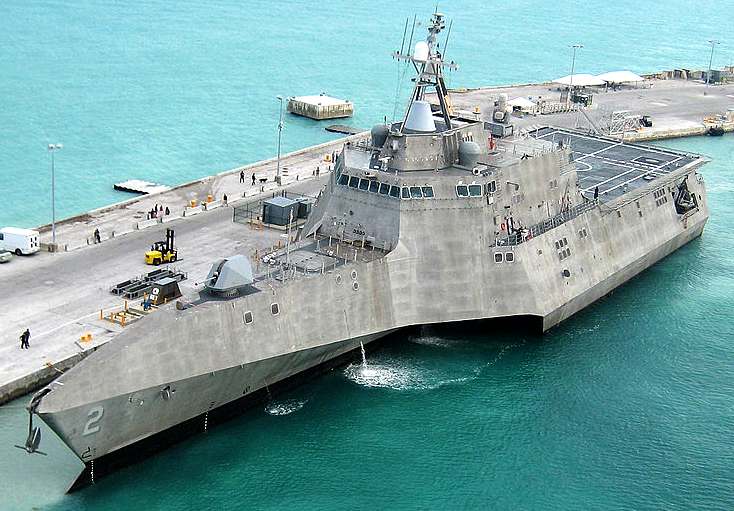
FREEDOM
and INDEPENDENCE CLASSES
The Freedom class and the Independence class were the first two variants of LCS by the U.S. Navy. LCS designs are slightly smaller than the U.S. Navy's guided missile frigates, and have been likened to corvettes of other navies. However, the LCS designs add the capabilities of a small assault transport with a flight deck and hangar large enough to base two SH-60B/F or MH-60R/S Seahawk helicopters, the capability to recover and launch small boats from a stern ramp, and enough cargo volume and payload to deliver a small assault force with fighting vehicles to a roll-on/roll-off port facility. The standard armament for the LCS are Mk 110 57 mm guns and Rolling Airframe Missiles. It will also be able to launch autonomous air, surface, and underwater vehicles. Although the LCS designs offer less air defense and surface-to-surface capabilities than comparable destroyers, the LCS concept emphasizes speed, flexible mission module space and a shallow draft.
The first littoral combat ship, USS Freedom, was commissioned on 8 November 2008 in Veteran's Park, Milwaukee, Wisconsin. The second ship, and first of the trimaran design, the USS Independence, was commissioned on 16 January 2010, in Mobile, Alabama. The third littoral combat ship, USS Fort Worth, of similar design to the USS Freedom, was commissioned 22 September 2012 in Galveston, Texas.
In 2012, CNO Jonathan W. Greenert said some of the LCS would be deployed to Africa in place of destroyers and cruisers. Then in 2013, the LCS requirement was cut from 55 to 52 ships, because U.S. Africa Command reduced the presence requirement. On 6 January 2014, the office of the secretary of defense (OSD) directed the Navy to reduce overall buys of the LCS from 52 to 32, in favor of a "more capable surface combatant." Navy leaders have asserted that budgets and acquisition changes have not been completed yet. By January 17, Navy leaders had managed to momentarily forego a final decision about changing LCS numbers.
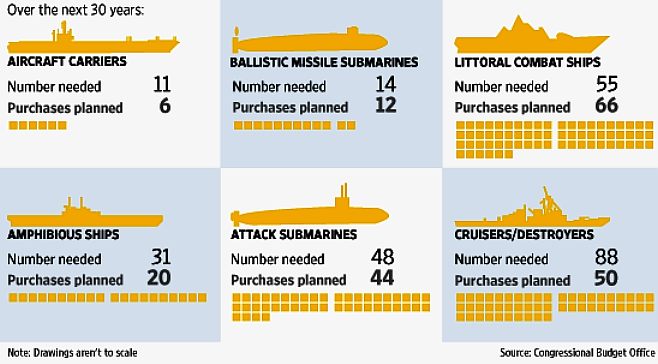
US NAVY LITTORAL DESIGN
Most of the functions of the mission modules are typically performed by carried vehicles such as
unmanned vehicles (Spartan Scout) AN/WLD-1 RMS Remote Minehunting
System and MQ-8B Fire Scout.
When considering the Combat ZCC platform for littoral development, onboard
helicopters will be spy drones.
By performing functions such as sonar sweeps for mines or submarines or torpedo launches against hostile submarines at some distance from the ship's hull, the crew is placed at less risk. This is part of
most Navies goals to "unman the front lines." The Combat ZCC is considered
to be the state of the art when it comes to autonomous unmanned ability and
endurance.
DARPA's
Tactically Exploited Reconnaissance Node (TERN) program aims to build a Medium-altitude long-endurance unmanned aerial vehicle (MALE UAV) that can operate from LCS-2 and can carry a payload of 600 pounds (270 kg) out to an operational radius of 600–900 nautical miles (1,100–1,700 km). First flight of a TERN demonstrator is expected in 2017.
By placing sensors on remote vehicles, the LCS will be able to exploit concepts such as bistatic sonar.
A report by the Pentagon's director of Operational Test and Evaluation found that
no design was expected to "be survivable in a hostile combat environment" and that neither ship could withstand the Navy's full ship shock trials. The Navy has responded that the LCS is being built to a Level 1+ survivability standard and that the ships will rely on warnings from networks and the speed of the ship to avoid being hit, or if hit be able to limp to safety.
Again, the US Navy should look into the Seawolf™ concept when evaluating survivability.
The combat abilities of the LCS were said to be "very modest" even before the cancellation of the XM501 Non-Line-of-Sight Launch System. The Independence variant is said to have better helicopter facilities and more internal space while the Freedom variant is said to be better able to launch and recover boats in high seas. Admiral Gary Roughead has said that a mix of both types would be "operationally advantageous".
Some of the LCS will rotate through Singapore. These two or four ships will not be based in Singapore and their crews will live aboard ship during their rotational deployments. The ships will be managed from, rather than based in,
Singapore for a six to ten-month deployment that includes port calls to other countries in the area.
In April 2012, Chief of Naval Operations Greenert said "You won't send it into an anti-access area." But Navy Secretary Ray Mabus clarified that the ship could operate in combat areas, as long as it remained under the protection of real warships.
Once again, with the Combat ZCC, each ship protects each other ship by way of
total support.
Conventional littoral ships were predicted to fall short in manning. And the US Navy has deployed the ships with berthing modules in the mission bays in order to carry the crew required for operations.
US littoral ships are designed with sufficient headroom to change from 2-high bunking to 3-high bunking, which would allow crew sizes of 100 if needed.
Most ships will be unable to defend themselves effectively against anti-ship cruise missiles, which are commonly employed in
US littorals and are also proposed for the Combat ZCC.
The LCS is the first USN surface combatant class in a generation to not use the Aegis Combat System, though Aegis-equipped variants of the LCS hulls have been offered to foreign customers. The LCS classes have suffered from problems in their communications and radars and will require refits in these areas.
MISSION
MODULES
The LCS is reconfigured for various roles by changing mission packages. Each mission package includes mission module equipment (weapon systems, sensors, etc.), carried craft and mission crews. Projected modules include Anti-submarine warfare (ASW), mine hunter (MCM), surface warfare (SUW), and special warfare missions. The MCM and SUW modules are planned to reach initial operating capability in Fiscal year 2014, and the ASW module in FY2016.
MODULE CHANGES
Module changes were envisioned to allow a single LCS to change roles in a matter of hours at any commercial port allowing a group of LCS' to optimize their effectiveness against a developing threat very rapidly. A report from the Office of the Chief of Naval Operations (OPNAV) based on the results of a January 2012 sustainment wargame is reported to state that, possibly for logistics reasons, the mission module changes may take as long as weeks, and that in the future the navy plans to use LCS ships with a single module, with module changes being a rare occurrence.
SURFACE WARFARE
The surface warfare mission module is intended to deal only with small boats and is called "best swarm killer in the surface fleet". It includes two 30mm gun mission modules manufactured by Teledyne Brown Engineering, Inc.
In January 2011, the U.S. Navy recommended that Raytheon's Griffin missile system be selected as the replacement for the NLOS-LS missile. This would lower the missile range of the LCS from 25 miles to 3.5 miles. The packages were to be deployed in sets of three, with 15 per set for a total of 45
missiles. Initial deployment was set for 2015, with a longer ranged version to have entered service around 2017. However this was canceled as the Griffin was judged to be "too lightweight". The longer range missile will be chosen in a competition for a "beyond the horizon" system. An enhanced Griffin and the Sea Spear variant of the Brimstone are considered likely competitors for the increment 2 missile.
In November 2013, the USS Fort Worth (LCS-3) conducted live-fire tests of its 57 mm and 30 mm canons against small boat targets conducting swarm attacks. The Fort Worth was moving fast through the water and assisted by an MH-60R helicopter. The ship's fire control system locked on to and fired on the small maneuvering boats in day and night situations with optical sights. The helicopter provided radar targeting which was passed on to the ship's fire control system. Test firing were successful, with additional evaluations of the complete surface warfare module scheduled for early 2014.
ANTI SUBMARINE MODULE
The anti-submarine module will have its focus changed from stationary systems to en-stride systems (while the ship is moving) that are useful in the open ocean as well as in coastal areas. One of the items to be added is a "torpedo detection capability" so that the ship can know when it is under attack. Thales has sold one CAPTAS 4 low-frequency active sonar to the
U.S. Navy to be towed behind the LCS, with a potential order of 25 units. The USN will test a combination of this unit, derived from the Sonar 2087 on British Type 23 frigates, with the TB-37 multifunction towed array found on US warships. As of September 2013, deployment of the ASW module is planned for 2016, but the 2013 sequestration cuts could push this back to 2017.
MINE COUNTERMEASURES MODULE
The Mine Counter-Measure (MCM) module is designed to provide minesweeping, where mines are detected remotely and bypassed, as well as minehunting, where mines are detected and then disabled. Presently the MCM module is envisioned to perform "influence" minehunting, which employs acoustic, and magnetic signatures, but not contact, or mechanical minehunting.
The MCM module includes the Airborne Laser Mine Detection system, the Airborne mine neutralization system, the AN/AQS-20A underwater towed sonar, the remote
mine-hunting system that will tow the AN/AQS-20A, the Coastal Battlefield Reconnaissance and Analysis system, the unmanned surface vehicle with unmanned surface sweep system, and the Knifefish, the Surface mine counter-measure unmanned undersea vehicle. Additionally before they were canceled, the MCM module was also to include the Organic Airborne and Surface Influence Sweep System, and the Rapid Airborne Mine Clearance System.
The full "threshold" performance MCM module is scheduled to be completed by 2019. The AN/AQS-20A, and the Airborne Laser Mine Detection System have been found to be unable to meet performance requirements in a single pass, requiring them to use multiple passes, degrading performance. The Remote Multi-Mission Vehicle's mean time before failure is 7.9 hours compared to the required 75 hours. The Airborne Mine Neutralization System cannot track mines because of software problems, and there are problems with the loading and unloading system.
While the
US Navy plans to release the final increment IV MCM module in 2019, this planned system will not have contact
mine hunting
capability, or an EOD team, which the Avenger Mine Countermeasure ship had to deal with contact mines, and give valuable intelligence data the EOD teams are trained to collect. It will also not have an in-stride capability, the ability to neutralize mines as they're found, the neutralization phase is preceded by post-mission analysis with the proposed system. As of September 2013, fielding of the first increment of the MCM module is planned for 2015, and the second in 2019.
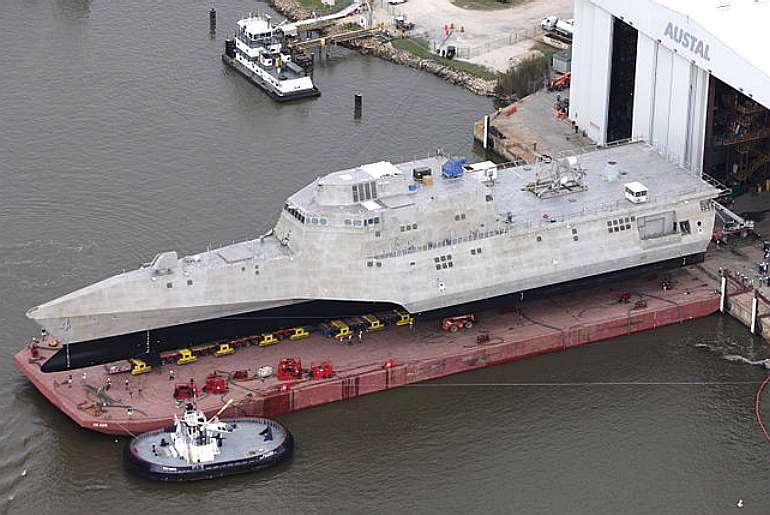
IRREGULAR
WARFARE & AMPHIBIOUS MODES
The Navy has included an irregular warfare package in its 2012 budget request to
Congress. The Spearhead-class Joint High Speed Vessels have also been weighed as possible platforms for Special operations support.
Under Secretary of the Navy Robert O. Work has said that Marines will deploy from littoral combat ships. Congressman Duncan D. Hunter (R-CA), himself a Marine Corps Reserve field artillery officer with combat experience in Iraq and Afghanistan, has written that the 55 LCS buy was made at the cost of 10 fewer amphibious vessels needed to support the USMC. Assistant Commandant of the Marine Corps, General Joseph Dunford has said that the LCS is one of the platforms under consideration to help close the gap in amphibious shipping. The Navy is currently working on the requirements for a module to support these sorts of operations.
HISTORY OF DEVELOPMENT USN
The United States Navy launched its first littoral combat ship, Sea Fighter, in 2003. Sea Fighter used a SWATH-type hull and was designated as fast sea frame or FSF-1. The ship was put into service in 2005 and serves as an experimental test bed ship using mission modules. Given that the Oliver Hazard Perry, Osprey, and the Avenger classes are all reaching end of life, the U.S. Navy released a requirement for the LCS class ships. In 2004, Lockheed Martin,
General Dynamics and Raytheon submitted designs to the Navy of their proposed littoral combat ships. It was decided to produce two vessels each (Flight 0) of the
Lockheed Martin design (LCS-1 and LCS-3) and of the General Dynamics design (LCS-2 and LCS-4). After these are brought into service, and experience has been gathered on the usability and efficiency of the designs, the future design for the class were to be chosen (Flight I). The ultimate decision was to fund both designs as two variants of the class. The Navy currently plans to build 55 of these ships.
On 9 May 2005, Secretary of the Navy Gordon R. England announced that the first LCS would be named USS Freedom. Her keel was laid down on 2 June 2005 at Marinette Marine, Marinette, Wisconsin.[58] The contract to build the ship was managed by Lockheed's Maritime Systems and Sensors (MS2) division, directed by Fred Moosally. On 23 September 2006, LCS-1 was christened and launched at the Marinette Marine shipyard. On 19 January 2006, the keel for the General Dynamics trimaran, USS Independence, was laid at the Austal USA shipyards in Mobile, Alabama. LCS-2 was launched 30 April 2008.
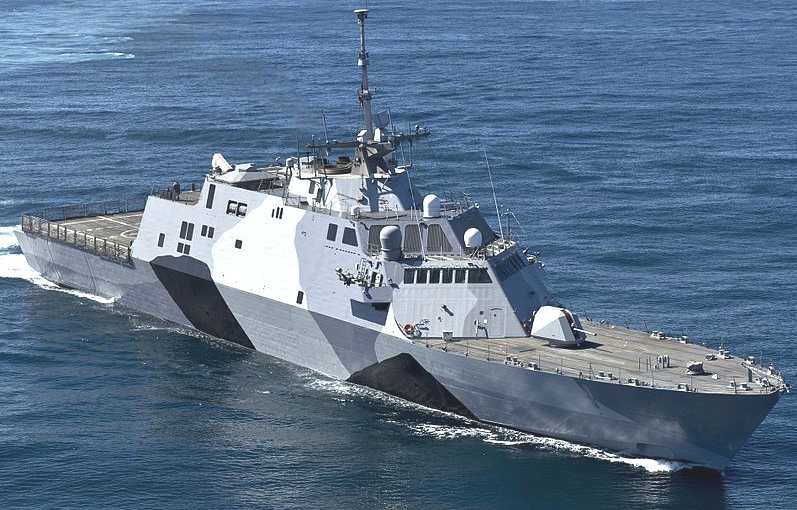
OPERATIONAL ISSUES
A 2012 report by Rear Admiral Samuel Perez, USN, found that the US Navy's
littoral ships lacked the manpower and firepower to complete the missions required by the regional combatant commanders. The report found that their Littoral Combat Ship is “ill-suited for combat operations against anything but” small, fast boats not armed with anti-ship missiles. It also found that the excessive beam of the trimaran Independence class ships may pose a "navigational challenge in narrow waterways and tight harbors". The report also found that the contractor-based maintenance scheme for the ships has performed poorly, with the poorly supervised and unaccountable contractors leaving problems for the crews. In addition these contract workers must by law be Americans, which will then need to be flown out to the foreign ports the LCS must return to for supplies and maintenance. A special panel was appointed to investigate "challenges identified" by the report.
In 2013, Captain Kenneth Coleman, the U.S. Navy's requirements officer for the program, identified tactical aircraft, such as strike fighters and maritime patrol
aircraft equipped with standoff anti-ship missiles, as a system the LCS would be especially vulnerable to.
Once again, this is an issue that the Combat ZCC proposes tacking head on.
Vice Admiral Thomas H. Copeman III is reported to be considering an upsized "Super" LCS, that would have space to install needed firepower, because he noted that the 57mm main gun was more suitable to a patrol boat than a frigate. Austal’s vice president for sales, Craig Hooper, suggested that the ships should instead be used for UAV operations. Navy Secretary Ray Mabus has called the lack of suitable missions for the LCS "one of its greatest strengths".
The various modules all use the same Internet Protocol formats, and the ships are reportedly prone to
Cyber-Attacks.
At a hearing on 25 July 2013, the House Armed Services Committee's seapower subcommittee argued with Vice Admiral Richard Hunt on how the LCS would be employed if tensions with North Korea or
China led to a confrontation in the Western
Pacific. Hunt said the ships are designed in accordance with the Navy's survivability standards, and that the LCS would be used during the initial phase in the theatre and sense the environment before hostilities occur. Republican Congressman Duncan Hunter countered saying the LCS was not survivable enough for long-range threats that China possesses. LCS class ships are built to the Navy's survivability category Level I+, higher than Level I patrol craft and mine warfare ships, but lower than the Level II Oliver Hazard Perry-class frigate they are replacing. The Navy has said the LCS was designed to pull out of combat upon sustaining damage.
The deployment of USS Freedom is seen by the Navy as an opportunity to test the ship and its operational concepts real-world environments. Congressman
Hunter replied that all that the Freedom had done so far was dock in harbors that other ships couldn't (demonstrating its shallow draft) and do "donuts" (move in fast circles in the water). Admiral Hunt told Hunter that the Navy was about to conclude a war game at the Naval War College to examine ways of exploiting LCS capabilities in a Western Pacific scenario, among others. Hunt added that the anti-submarine warfare (ASW) mission package would play an important role in protecting aircraft carriers and amphibious ships. The
mine countermeasures (MCMs) mission package would also provide necessary port security and waterway patrol capability in a region following major combat operations. The MCM mission package is expected to reach initial operational capability (IOC) in 2014, and the ASW mission package is expected to reach IOC in 2016.
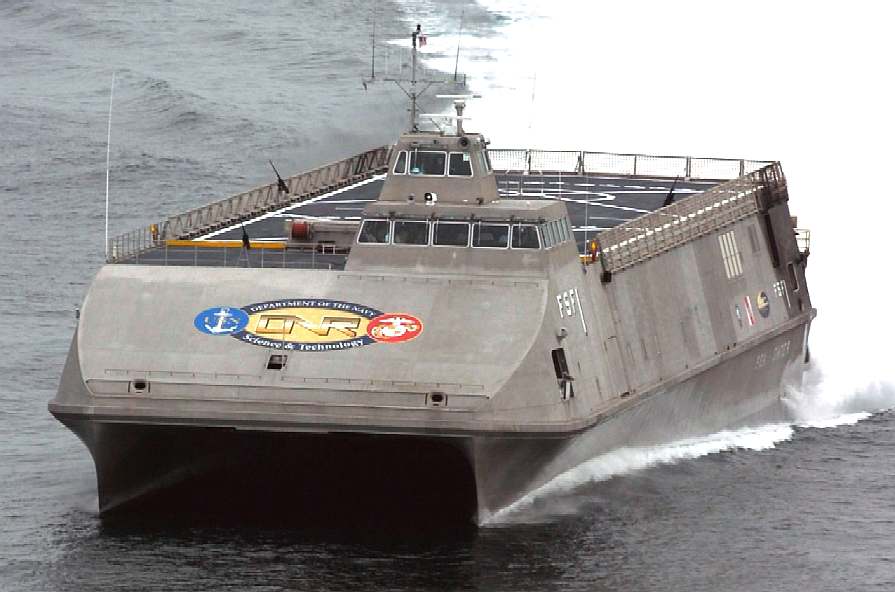
The
Sea Fighter looks more like an unimaginative floating helicopter pad. What is
new about that? The SWATH hull form appears to generate significant drag
as evidenced by the wash she is generating - and where are the weapons that
might fend off an air strike? At least they built something different. The next
step is to build something that works to save navies operational costs, while
improving combat performance.

SEA FIGHTER BMT NIGEL GEE LTD
Sea Fighter (FSF-1) is an experimental littoral combat ship under development (2005-2008) by the United States Navy. Its hull is of a small-waterplane-area twin-hull (SWATH) design, provides exceptional stability, even on rough seas. The ship can operate in both blue and littoral waters. For power, it can use either its dual
gas turbine engines for speed or its dual diesel engines for efficient cruising. It can be easily reconfigured through the use of interchangeable mission modules.
Helicopters can land and launch on its deck. Smaller water craft can be carried and launched from its stern. The vessel is being developed under the program title Littoral Surface Craft-Experimental (LSC(X)) with a hull type designation Fast Sea Frame. The first vessel has been assigned the hull classification symbol FSF 1 and also has been referred to as the X-Craft. The vessel was designed by British company BMT Nigel Gee Ltd (formerly BMT Nigel Gee and Associates Ltd) who continue with a role in the development of the vessel.
Sea Fighter's hull is a small-waterplane-area twin hull (SWATH) design, constructed out of aluminum.
With twin gas turbine engines, quad water jets, and a streamlined hull, Sea Fighter is capable of speeds of 50 knots (90 km/h) and greater. It is designed to be a sea frame that can carry interchangeable mission modules resembling shipping containers. These modules allow it to be easily reconfigured to meet a variety of mission requirements, including mine warfare,
anti-submarine operations, amphibious assault support, surface warfare, transport and logistical missions, cruise missile launch, and special forces interdiction operations. The mission modules are easily loaded and stored on Sea Fighter’s inner deck.
The vessel has the capability of launching small craft up to 11 m in length from the stern, including assault craft and submersibles by means of a custom dual purpose ramp that also enables RORO operations for HMMWV and other vehicles. The vessel also has a twin-pad helicopter deck capable of operating aircraft up to the size of an H-60 type, including unmanned aerial vehicles, and landing helicopters while traveling at speeds of up to 50 knots (90 km/h). A special deck lighting system has been developed for Sea Fighter using low intensity green
lighting around the vessel's edges and helipads. This lighting is particularly effective when using night vision goggles, making landings on the vessel easier than on conventional warships, even at the higher speeds in which Sea Fighter operates.
The basic design has a displacement of 1,100 tons while measuring 79.9 m (73 m at waterline) long and 22 m broad. Power is provided by a CODOG arrangement comprising two MTU 595 diesel engines and two LM2500 gas turbines. Diesel power is used for cruising while the turbines provide high power output for high speed operation. The two gas turbines power the vessels quad water jets, drawing water from the bottom stern of each hull and powering it through large water turbines, which are responsible for the vessel's remarkable speed. Each
water jet has thrust vectoring and thrust reversers making it possible for Sea Fighter to move sideways while docking, or even traveling in reverse. Thrust vectoring also makes it possible for Sea Fighter to make dramatic evasive maneuvers while traveling at high speed. This would prevent the craft from being forced to shore or into the path of enemy vessels.
Sea Fighter's forward superstructure consists of a bridge on the lower deck, and a flight operations station on top. The bridge is relatively small, and generally manned by a crew of three. The bridge control stations incorporate glass displays using the latest in
navigational aids to assist Sea Fighter in patrolling coastal areas while operating at high speed. Maneuvering Sea Fighter is more reminiscent of the operation of a Landing Craft, Air Cushioned (LCAC) than a conventional warship. Above the bridge is a small flight operations station with room for only one operator. This glass enclosed station provides an excellent view of the entire flight deck, and allows the operator to coordinate the approach and landing of helicopters, and loading of the vessel's mission containers, as well as providing visual aid for navigation.
The ship has a modern computer system to control its systems and for navigation. Steering and throttle control are done by wire rather than mechanical linkage.
The first vessel of the type (FSF 1) was constructed at the Nichols Bros. Boat Builders shipyard at Freeland, Washington, under contract to Titan Corporation, a subsidiary of L-3 Communications. Nichols Shipyard was selected because of their previous experience in the construction of
aluminum-hulled high speed ferries.
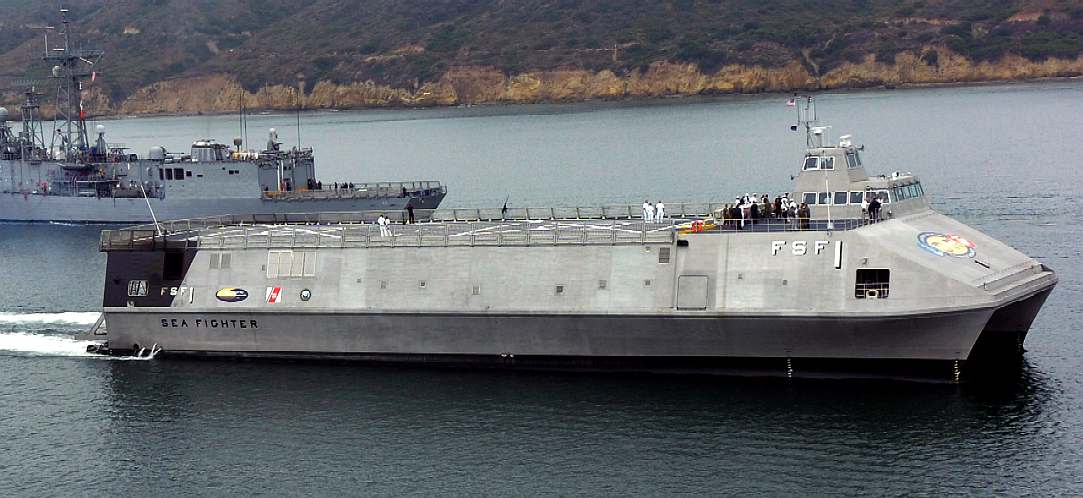
The
Sea Fighter is under-armed and vulnerable if it is genuinely to be considered
for use as a littoral combat vessel. In addition, as you can see from this
picture, she frequently travels with an incorrect attitude, raising the power
needed to move.
SEAFIGHTER ROLE & FUTURE DEVELOPMENT
ROLE
The Sea Fighter is destined for employment by the Office of Naval Research as a testbed for technologies related to the Navy's littoral combat ship effort, as well as direct testing of the hull design. Once trials are completed, the Navy will have the option of outfitting the vessel for operational deployment.
FUTURE DEVELOPMENT
The Navy and Coast Guard are jointly exploring the possibility of further development of Sea Fighter-type vessels for use in patrolling U.S. coastal waters. With an effective range of 4,400 nautical miles (8,100 km) unrefueled the type could also be deployed quickly overseas for similar duties. Sea Fighter is expected to pave the way for a future line of fast, long-range destroyers capable of travelling fast enough to avoid or outmaneuver most of the current generation of
torpedoes. Such vessels would be capable of crossing the
Atlantic Ocean un-refueled, and have a very low
radar signature, making detection difficult. They would be able to respond quickly to targets located by air or satellite and aggressively attack surface and submerged vessels using their speed to evade torpedo and missile attack.
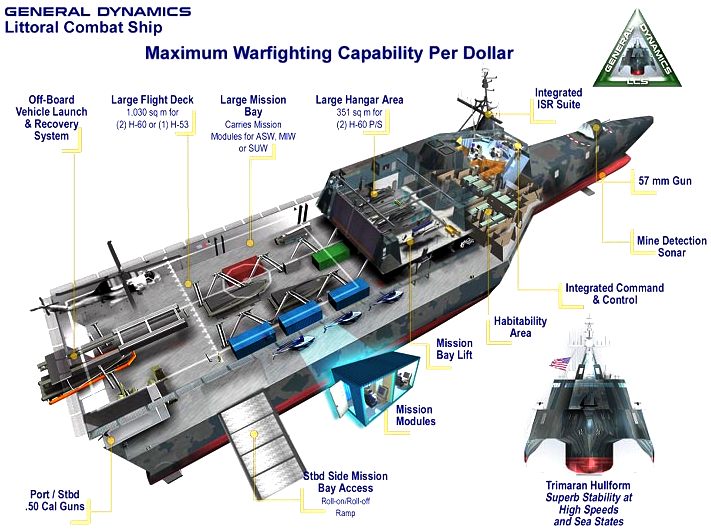
DD
21 ZUMWALT FORERUNNER TO LITTORAL COMBAT SHIPS
The DD-21 Zumwalt-class Land Attack Destroyer replaced the DD 963 and FFG 7 Classes of destroyer and frigate in the US NAvy's inventory. The DD 21 System will provide an advanced level of land attack in support of the ground campaign and contribute to naval, joint and combined battlespace dominance in littoral operations. The DD 21 will be a true fleet destroyer, capable of handling any mission that a Fleet commander might ask, from key wartime missions in land attack and undersea warfare to the equally important presence missions, noncombatant evacuations, escort, and diplomatic missions that have been closely associated with Navy destroyers for almost a century.
Like
the Arleigh Burke-class guided-missile destroyers, DD 21 will be a multi-mission ship, capable of providing forward presence and deterrence, and operating as a vital part of naval, joint and combined maritime forces to gain battlespace dominance in littoral operations. But unlike
the then destroyers, DD 21's primary mission will be land attack support for ground forces. Armed with 5-inch/62 extended range guided munitions and 155mm Howitzers, the ship will provide naval gunfire support up to 100 miles inland. A land attack missile system will extend support between 100 and 200 miles. Tactical
Tomahawk missiles will be able to reach targets from 200 to 1,600 nautical miles.
DD 21 will have the most advanced undersea warfare combat systems ever installed on a surface combatant. The ship's hangar will house attack helicopters as well as a system of unmanned aerial vehicles (UAV). In concert with other ships, DD 21 will contribute surveillance and force to establish and maintain local air superiority.
The DD 21 program emphasizes more than just improved offensive and defensive capabilities. Because DD 21's design will incorporate only the most advanced systems and materials on the market today, ships of the class can remain battle-ready with minimal maintenance and greatly reduced manpower. Design characteristics such as submarine-like survivability and a significantly reduced radar signature, achieved through a fully integrated topside design, will significantly expand the mission of the surface combatant.
As with previous destroyer designs, DD 21 will be focused on the key mission areas facing the nation and the Navy during its design phase. The Navy believes it needs a destroyer that is capable of exceptional performance in the littoral regions of the world and one that can provide significant support to forces ashore. As a result, DD 21 must excel in mission areas that include land attack and maritime dominance. DD 21 will provide an advanced level of land attack in support of the ground campaign, while contributing to naval, joint, and combined battlespace dominance in littoral operations. Given the large inventory of upgraded CG 47 and new DDG 51 Class ships that will be in the fleet by the time the first few DD 21 class ships begin to join the fleet after 2008, a robust self defense capability in air defense will be sufficient for this ship.
The DD 21 ships must possess the operational flexibility to meet the
multi-mission forward presence and war-fighting requirements of the littoral environment and employ self defense against the threats documented in the 21st Century Surface Combatant Program System Threat Assessment Report. The DD 21 ships must also be capable of taking advantage of and maintaining the benefits of the military revolution stimulated by the rapid advances in information and information related technologies and exploit them through automation and system architectures capable of disseminating information to widely dispersed and dissimilar units to achieve an overall dominant maneuver concept of operations, as outlined in Joint Vision 2010 and concepts for future joint operations.
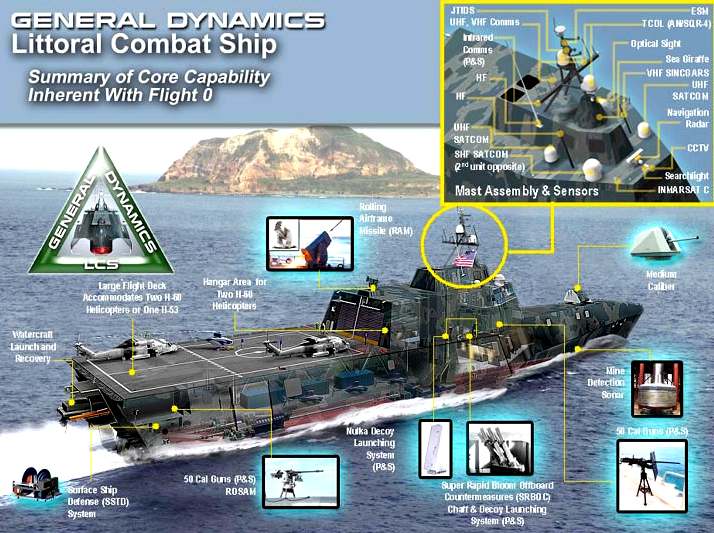
The Navy evaluated the benefits of incorporating other programs into this DD 21 acquisition, including the following:
1. Advanced Computing - 21 (ADCON-21)
2. Vertical Gun for Advanced Ships (VGAS)
3. Multi-function Radar (MFR)
4. Under Sea Warfare -21 (USW-21)
5. Naval Surface Fire Support Weapon Control System (NWCS)
6. Integrated Propulsion System (IPS)
7. Volume Search Radar (VSR)
8. Integrated Topside Design (ITD)
The Navy has incorporated the Maritime Fire Support Demonstrator (MFSD) lessons learned into the DD 21 program. This included transferring the MFSD contract deliverables and the bulk of the people working on MFSD to the DD 21 Program Office. Analysis of all three Maritime Fire Support Demonstrator proposals has been completed, and the good aspects of the program, of which there were many, are being incorporated in the DD 21 and CVX programs. The Navy incorporated the MFSD lessons learned into the DD 21 program. Besides transferring all of the contract deliverables and most of the personnel supporting the MFSD program to the DD 21 Program Office, the Navy also incorporated key MFSD precepts into the DD 21 acquisition strategy including:
A. Early industry involvement to reduce life-cycle costs and to focus contractor expertise on total ship integration.
B.
The use of Section 845 contracting strategy to encourage Industry participation and innovation.
C.
Employment of state-of-the-art engineering tools for Modeling and Simulation and Computer Aided Design (CAD) to explore the effects of alternative system characteristics on system performance and life cycle cost.
D.
Extensive use of commercial components to meet the cost effectiveness requirements levied on the program.
E.
Integration of industry risk mitigation techniques along with an appropriate mix of at-sea and land-based testing.
F.
Use of "Cost as an Independent Variable" (CAIV) principles to ensure meeting the cost and affordability goals of the program.
The Navy has completed a review of the MFSD industry team proposals, and has determined that a significant number of the technical concepts used for MFSD are also applicable to DD 21. Two examples are revolutionary manning and signature reduction initiatives. Although the MFSD program was not afforded the opportunity to demonstrate these and other innovative technologies at sea, the effort pursued for MFSD supports the requirements levied upon for DD 21.
Cost is a key factor in the design of these ships. Projected shipbuilding budgets, declining operations and maintenance budgets, coupled with plans to recapitalize submarine, aircraft carrier, and logistics fleets in the early 21st Century dictate that DD 21 must be an affordable ship to build and operate. This has led the Navy to seek, and find, new approaches to ship design and acquisition and apply them to DD 21.
The DD 21 program is fostering increased industry involvement and enhanced opportunities for industry competition through use of innovative acquisition strategies and is currently considering use of Section 845/804 authority for the first portion of the DD 21 development process. The surface combatant acquisition community has been completely reorganized to allow for this, and the Navy's FY 2000 budget request will show a significant realignment of DD 21 funding request as the full effects of the revolutionary acquisition strategy for DD 21 take effect. Competitive industry involvement is critical to the success of this program, and the Navy is working closely with the Office of the Secretary of Defense to foster a competitive environment.
The cost savings that can be derived from the DD 21 class destroyers include savings in construction costs that would result from achievement of the Navy's target per-ship cost of $750,000,000 by the fifth ship constructed in each construction yard;
* savings that would result from the estimated reduction of the crews of destroyers by 200 or more personnel for each ship; and
* savings that would result from a reduction in the operating costs for destroyers by an estimated 70 percent.
To implement Cost as An Independent Variable (CAIV) in order to achieve an Operations and Support (O&S) cost of $2,700 or less per hour underway and a production Objective/Threshold cost of $650/$750 million for the fifth DD 21 System in FY 96 dollars. For a year of ship operation, 3,274 hours are steaming hours underway and 1,886 hours are steaming hours in port, the remaining hours are hours in port in which "hotel" services are provided. For the $650/$750M targets, assumptions for the timing and procurement rates for buying these ships are a quantity of 32 DD 21s, at a rate of three per year beginning one year after the lead ship award.
AIR DOMINANCE
For air dominance, DD 21 will employ a leading edge radar suite tailored for littoral operations. This radar suite combined with surface-to-air missiles and cooperative engagement capability will support the requirement to establish and maintain local area air superiority. The Multi-function Radar (MFR) is a key part of the next generation AAW System. As low elevation air threats continue to evolve in capability, advances in radar technologies become essential to support operational and manning requirements. MFR, to be designed and built by Raytheon Systems Corporation, is a solid state active array radar system. This radar is more than a cruise missile defense radar. It must provide ulti-function surveillance that can meet the performance requirements in all related mission areas. The Volume Search Radar (VSR) will complement the MFR. It will provide situational awareness, air control, track identification and counter battery locating data. The VSR will provide cue quality track data to the MFR and complement MFR for ship self defense.
DD 21 will operate and support LAMPS helicopters and remote minehunting systems as well as broadband sonars. These organic systems will support a variety of littoral missions including battlespace surveillance, over-the-horizon identification and targeting, in-stride mine avoidance, and localization and destruction of enemy submarines.
To improve survivability in this complex and dynamic environment, DD 21 will be designed with
stealth technologies to reduce its visual, radar, infrared, acoustic, and magnetic signatures. DD 21 will have an integrated topside design with an advanced superstructure and advanced multi-function apertures. In addition to improving self-defense, DD
21s revolutionary signature reduction will greatly enhance its offensive capabilities by allowing it to operate closer to shore despite threat conditions. The unique notional DD 21 hull form is a dramatic visual representation of the vastly reduced signatures envisioned for this combatant.
As the first U.S. warship to incorporate an integrated approach to signature reduction, DD 21 is the critical bridgehead for development of these technologies. While specific types of signature-reducing technologies will not be disclosed until the Navy downselects to one industry team ship design concept in 2001, requirements to reduce DD 21's radar signature necessitate an integrated topside design (i.e. reduced signatures through the use of an advanced superstructure incorporating embedded multi-function apertures for antenna and electronic systems).
The ship design will also likely include radical composite construction materials, some radar absorbing materials, and optimized hull shaping both above and below the waterline. Extensive attention will also be given to acoustic quieting and degaussing for both equipment and propulsion systems. The integrated power system is expected to provide substantial quieting capability.
Technologies being developed for potential inclusion in a damage-tolerant DD 21 design include a shock-resistant hull, a robust electrical power distribution system, and an integrated magazine protection system. DD 21 survivability performance must support damage control operations in a reduced manning environment. This may be satisfied with advanced automation, sensors and control, and systems such as robotic fire-fighting. Automated systems will be used to pre-configure and reconfigure systems for combat; monitor equipment status; and detect and counter smoke, fire and flooding.
Integrated Power System (IPS) is the all-electric architecture for future ships, providing electric power to the total ship (propulsion and ship service) with an integrated plant. IPS offers reduced costs of ownership, reduced construction costs, improved survivability, and greater architectural flexibility. The Integrated Power System (IPS) will provide total ship electric power, including electric drive, for all future surface ships including surface combatants, amphibious, auxiliary, and command ships. Near term ship targets include but are not limited to DD21, CG 21, JCC(X), and LH(X), with potential application to future flights of LPD 17. The electric power system must meet individual ship requirements, support all ship systems, and be able to support operations for as long as the ship remains afloat. These ships must operate wherever required, particularly in littoral waters, to enable joint maritime expeditionary force operations and project precise strike power ashore.
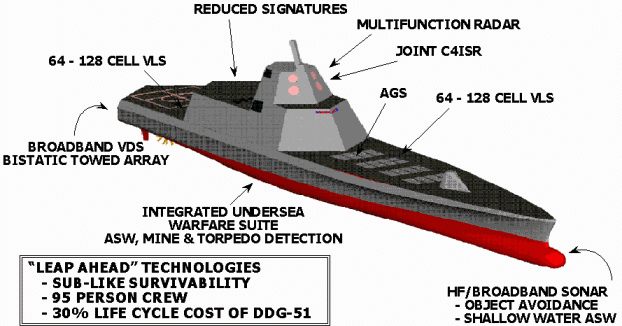
LITTORAL SHIPS INTERNATIONAL INTEREST
Saudi Arabia and Israel have both expressed an interest in a modified version of the
US Freedom variant littoral ship, the LCS-I, but Defense News has reported that Israel has dropped out of this project in favor of a new frigate design to be built in Israel.
The Republic of China Navy (Taiwan) has also shown interest in procuring U.S. littoral combat ships, to replace aging Knox-class frigates.
The Royal Malaysian Navy intends to purchase much smaller ships that they call littoral combat ships, but their use of the term has been disputed.
Why bother disputing a term, it is the firepower and effectiveness in a role
that counts.
The Indonesian Navy was reportedly interested in either purchase or construction of littoral combat ships to protect Indonesia's wide ocean territory. Early images indicate a
trimaran design much like the Independence variant ships (LCS-2).
AUTONOMOUS
LITTORAL SHIPS
For the purposes of this
subject, we are assuming that weaponized unmanned maritime systems of increasing complexity and degree of autonomous operation will be deployed in the
future by nearly all countries operating ships, etc. Indeed, that is our mantra.
The focus of our analysis will be on the legal compliance as relates to the
deployment of Seawolf
enabled vessels.
MISSIONS
FOR AUTONOMOUS LITTORAL SHIPS
The seven missions identified
for the Combat ZCC are:
(1)
Mine Countermeasures (MCM);
(2) Anti-Submarine Warfare (ASW);
(3) Maritime Security (MS);
(4) Surface Warfare (SUW);
(5) Special Operations Forces (SOF) Support;
(6) Electronic Warfare (EW); and
(7) Maritime Interdiction Operations (MIO) Support.
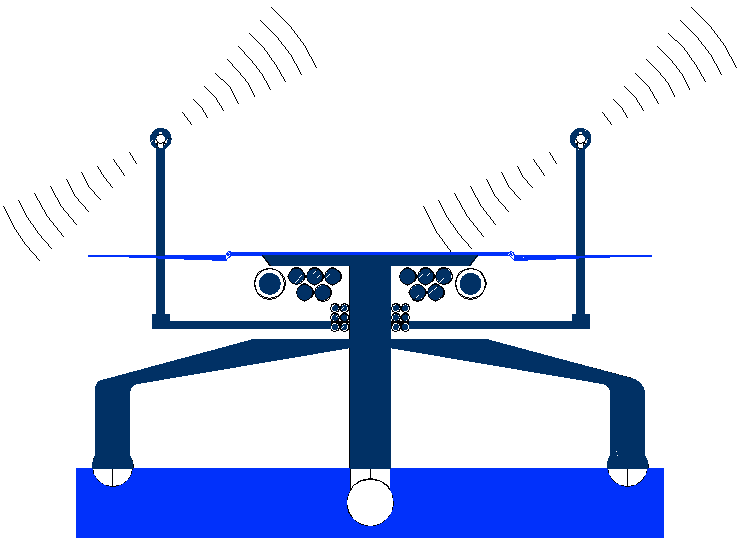 |
| . |
|
A
robotic (drone) semi-autonomous littoral combat ship. This proposed version is fully autonomous while patrolling, switching to
semi-autonomous drone mode when encountering other vessels. The ship may cruise continuously at 7-10
knots on renewable energy, sprint to 20 knots
using batteries and up to 40 knots using fuel cells and other active
hull features. This is a very low cost endurance vessel, that is
designed to operate in close cooperation with other similar vessels to
patrol sovereign and other navigable waters to fend off possible
amphibious and other close to shore operations that threaten homeland
security. |
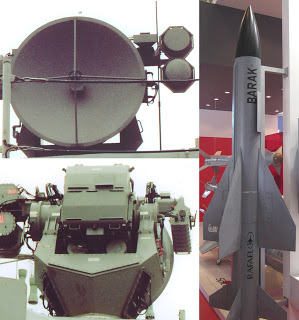
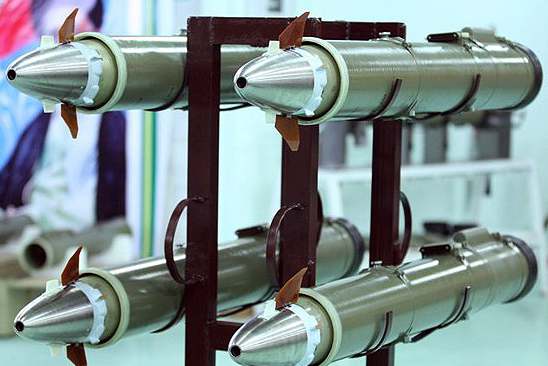
These
missiles are autonomous weapons, no matter who pushes the firing button. Does it
then matter how automated the delivery platform is. Better we say to do battle
remotely to save lives. If the delivery platform uses no diesel and has a higher
endurance, is that not a good thing. A human is not capable of reacting quickly
enough in any event, such as to track and destroy incoming threats.
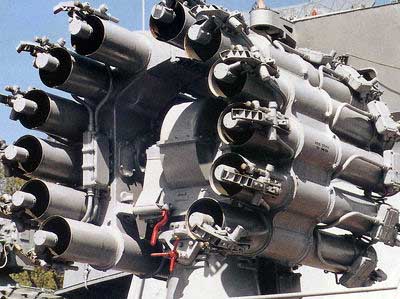
SEMI AUTONOMOUS
A definition of “semi-autonomous” is that the decision to pull the trigger or
launch a missile from an unmanned system will not be fully automated, but will remain
under the control of a human operator.
“Fully autonomous” signifies full-scale autonomy,
with a weaponized ASV making mission decisions from identification to classification to
firing, based on pre-programmed parameters.
21st
CENTURY MARINE OPERATIONS
Most
navies are either making, planning or keeping tabs on autonomous developments
with a view to increasing their arsenal. Every navy is now required to comply
with MARPOL, which in our view includes the long-term pollution issues
associated with nuclear power - or at least it should.
This is where autonomous ZCCs come in. They
reduce the operational costs in terms of pollution - to the point where such
networks will become essential
- much as the MQ9
Reaper UAVs are today in the air.
LINKS
& REFERENCE
http://www.bmtng.com/
http://www.lockheedmartin.com/
http://www.raytheon.com/
http://www.generaldynamics.com/
http://en.wikipedia.org/wiki/Sea_Fighter
http://www.bmtng.com/
http://en.wikipedia.org/wiki/Littoral_combat_ship
http://www.unmannedsurveysolutions.com/
Submarine
Warfare
List
of sunken nuclear submarines
Battle
Pirates
http://en.wikipedia.org/wiki/Zumwalt_class_destroyer
http://en.wikipedia.org/wiki/Hull_classification_symbol
Daily
Mail
Navy-set-introduce-self-guided-unmanned-patrol-boats-fleet-year-swarm-attack-potential-threats
Extreme
Tech US Navy deploys autonomous unmanned swarmboats to keep its larger
ships safe
http://www.theguardian
US Navy unmanned drone boats
Wired
2014 US Navy self driving swarmboats
http://www.extremetech.com/extreme/191680-us-navy-deploys-autonomous-unmanned-swarmboats-to-keep-its-larger-ships-safe
http://www.theguardian.com/us-news/2014/oct/05/us-navy-unmanned-drone-boats
http://www.wired.com/2014/10/navy-self-driving-swarmboats/
http://battlepirates.wikia.com/wiki/Hulls
SUBMARINE
INDEX
HMS
Astute 1st of Class
BAE Systems
HMS
Vanguard- Trident
INS
Sindhurakshak - explosion
& sinking
Lusitania
- Torpedo
attack
Predator
- Covert submarine hunter/killer
Seawolf
- Autonomous wolf pack deployment of Predator mini-subs
U20
- Kapitan Leutnant Walther Schwieger
USS
Bluefish WWI submarine
USS
Bluefish - Nuclear submarine
USS
Flying Fish
USS
Nautilus - 1st nuclear submarine & subsea north pole passage
USS
Virginia - Class nuclear submarines
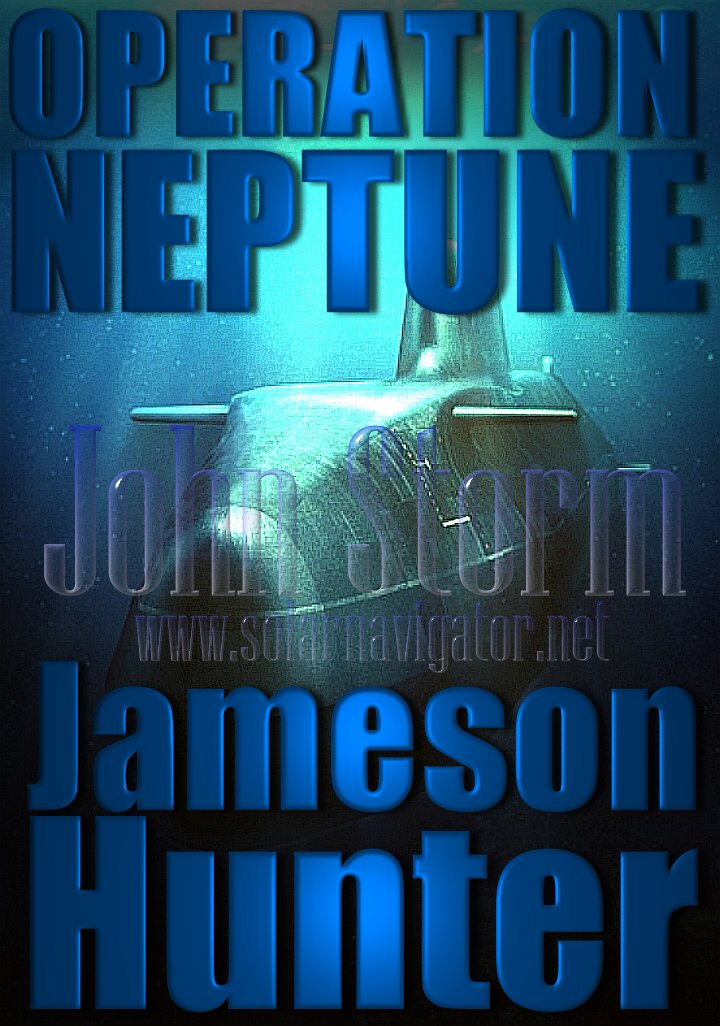
FICTION
Operation
Neptune - An
advanced nuclear submarine is hijacked by environmental extremists intent on
stopping pollution from the burning of fossil fuels. The extremists torpedo a
number an oil well as part of a campaign to cause energy chaos, with bigger
plans to come. To stop them NATO send in
the big guns, only to lose the Jimmy Carter nuclear submarine and the
Queen Elizabeth aircraft carrier. If you enjoyed
Under Siege or The
Hunt for Red
October, this is a
must for you.

|















